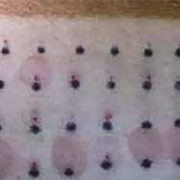Inflammation: It’s a pain when things blow up!
Odette O, DVM, DACVAA
Massachusetts Veterinary Referral Hospital
Posted on 2017-03-21 in Anesthesia & Analgesia
Pain is “an unpleasant sensory and emotional experience associated with actual or potential tissue damage or described in terms of such damage. The inability to communicate in no way negates the possibility that an individual is experiencing pain and is in need of appropriate pain relieving treatment.”
International Association for the Study of Pain
Though there are many types of pain that exist in our patients, all of those who present for a procedure where pain needs to be treated should be assessed for the presence and/or potential for inflammatory pain! Inflammatory pain originates from tissue damage and includes a wide range of clinical manifestations including surgery, arthritis, trauma, infection, etc. Traditionally, inflammation has been described as possessing the following characteristics: redness and heat (aka, rubor & calor). This causes swelling and pain (aka, tumor and dolor). Unmanaged pain has a variety of negative consequences in our patients, ranging from behavior to physiological. It is important to control inflammatory pain in order to both help the patient to feel better at present, as well as to prevent the potential for the development of chronic pain.
Pain pathway pathophysiology of inflammation
The pain pathway includes transduction (at the site of injury), transmission (A-delta and C fibers carry transmission to the spinal cord), modulation (input is modified at the spinal cord), and perception (conscious recognition of pain). Even if our patients are under general anesthesia and unable to perceive the pain, they will eventually wake up and have these pathways “revved up”. Inflammatory pain occurs at the transduction portion of this pathway where nociceptors (aka peripheral pain receptors) are stimulated by noxious stimulus. Tissue damage then causes the release of a number of chemical mediators including norepinephrine, 5HT, prostaglandins, leukotrienes, cytokines such as TNF-alpha, and substance P amongst others. This results in localized inflammation and corresponding pain, as well as the potential to create a “sensitizing soup” that may leave the pathway for peripheral sensitization resulting in primary hyperalgesia, changing this acute, physiologic pain into pathologic pain if left untreated.
Pre-emptive analgesia, administration of a pain relieving drug before the occurrence of painful stimuli, is important because it results in a reduced total amount of pain medication dispensed, and has an important role in preventing peripheral and/or central sensitization.
Local Anesthetics
Aside from providing multi-modal analgesia at the level of transduction via sodium channel blockade, local anesthetic drugs such as lidocaine have been shown to attenuate inflammation. How this process occurs is multi-factorial including more than simply sensory blockade decreasing substance P release and edema, but also by diminishing the actions of polymorphonuclear (PMN) cells and related release of inflammatory mediators and oxygen free radicals, as well as by decreasing microvascular permeability and albumin extravasation in some tissues. Note: despite potential benefits, the use of local anesthetics is not recommended in acid and/or infected tissues.
Steroids
The use of steroids to decrease inflammation has been around in veterinary medicine for a long time. Steroids are currently the least selective anti-inflammatory drug available, inhibiting phospholipase A2, the precursor to arachidonic acid. Interestingly, endogenous glucocorticoids seem to mediate some mechanisms of analgesia, including endogenous opioids. The use of exogenous steroids will have the positive effects of decreasing inflammation through the inhibition of prostaglandins and leukotrienes with the result of decreasing pain. Since most dosing guidelines available are either empirical or based on extrapolation from human data, careful consideration must be given to dosing this category of drugs since the aim is to suppress inflammation without causing immunosuppression! Whenever possible, short-acting formulation of steroids including prednisone, prednisolone, methylprednisone, and dexamethasone are preferred when given systemically. Since their effects are observed in almost every body tissue, there is a high potential for side effects and toxicity with this group of drugs. As a result, steroids should be used sparingly and with caution – the old adage about the “double-edged” sword of steroid use stands true. Toxicity seems to be both dependent on dose and duration of use, and may include: iatrogenic hyper- or hypo-adrenocorticism, neuropathy & myopathy, PU/PD/PP, fluid and electrolyte abnormalities, GI ulceration, delayed wound healing, immunosuppression, insulin resistance, and hepatopathy.
Non-Steroidal Anti-Inflammatory Drugs (NSAIDs)
Since the use of willow bark containing salicylates for centuries and Felix Hoffman working for Bayer’s discovery of aspirin in 1878, we have come a long way… or have we? NSAIDs are currently the most widely used anti-inflammatory agent in veterinary medicine. Perhaps this is the reason that they are also the LARGEST group of drugs reported as having adverse effects to the US FDA Center for Veterinary Medicine. (NOTE: this is not a reason to avoid prescribing these drugs, it is just a reminder to select patient and dose wisely, and to educate the client!) NSAIDs are very commonly used for good reason: They are excellent analgesic, anti-inflammatory, and anti-pyretic agents! These drugs are an extremely important part of a multi-modal analgesic plan. They are potent anti-inflammatories and also spare our use of pure-mu agonist opioids thereby avoiding some of their negative effects such as dysphoria and constipation. They have no abuse potential from the client, rarely cause sedation in our patients, and also have the vital benefit of being very effective at decreasing inflammation. We will review how they work so that we also understand our concerns with side effects… Remember the Arachadonic Acid (AA) Cascade?!? In this process, the rate-limiting step is the release of AA from membrane phospholipid catalyzed by enzyme phospholipase A2. Next, COX (cyclooxygenase) oxidizes AA (arachidonic acid) to PGs (prostaglandins) and LOX (lipoxygenase) oxidizes AA to leukotrienes. PGs are everywhere, act locally at their site of production, and are responsible for many functions. These functions include mucosal defense, platelet aggregation, regulation of renal blood flow, fever initiation, as well as inflammation. Thus, inhibition of COX in order to decrease PG production can lead to side effects such as renal insufficiency, bleeding disorders, and gastrointestinal ulceration. However, not all NSAIDs are created the same. Older drugs such as aspirin, phenylbutazone, and flunixin meglumine are nonselective COX inhibitors, inhibiting COX1, COX2, and COX3. However, since COX2 has been found to be upregulated up to 20x in inflamed tissues, the newer COX2 inhibiting preferential drugs (carprofen, meloxicam) were created with the hope of decreasing undesirable side effects. However, similar negative side effects are seen with these products. Then, the introduction of inhibiting COX2 selective drugs (deracoxib, firocoxib, robenacoxib) generated new hope once again. Unfortunately, similar concerns with use of this class of drugs still exists. For therapeutic considerations, it is important to keep in mind that NSAIDs have a NARROW safety margin, so it is important to remind the client NOT to exceed upper dose limit. For long-term NSAID users, use the lowest effective dose (as much as necessary within label dose, but as little as possible) may help to mitigate some negative effects associated with administration of this class of drugs. It is very important to individualize a patient plan, educate clients about potential concerns, as well as to monitor the patient regularly (PE, U/A, blood work). If switching between one type of NSAID to another or from a steroid to and NSAID, a “wash out” between drugs of 7 days minimum is recommended in order to decrease risk of GI ulceration.
Contra-indications to NSAID use include:
- Acute renal insufficiency (ARI)
- Hepatic insufficiency
- Uncorrected dehydration
- Hypotension / hemorrhage
- Coagulopathies
- GI ulceration
- GI surgery (?)
- Mast cell tumor surgery (?)
- Concurrent use of other NSAIDs or corticosteroids
- Breeding / pregnancy
A New Product on the Horizon?
Grapiprant is a novel drug for treatment of osteoarthritic pain in canine patients. The EP4 receptor has been identified as specifically being involved in arthritic pain and inflammation in experimental rodent research. Grapiprant is a highly selective, potent inhibitor of the PGE2EP4 receptor. Published data on the safety of the long-term use of this medication in healthy dogs looks promising.
Other Ways to Decrease Inflammation
- Ice
- Acupuncture
- Hydrotherapy
References
- Hollmann MW, Durieux ME. Local Anesthetics and the Inflammatory Response: A New Therapeutic Indication? Anesthesiology 2000; 93:858–75.
- Muir WW, Woolf CJ. Mechanisms of pain and their therapeutic implications. J Am Vet Med Assocs 2001 Nov 15;219(10):1346-56.
- Rausch-Derra LC, Huebner M, Rhodes L. Evaluation of the safety of long-term, daily oral administration of grapiprant, a novel drug for treatment of osteoarthritic pain and inflammation, in healthy dogs. Amer J Vet Res 2015 Oct; 76(10): 853-859.
About the author
|


 Dr. O is a 2004 Doctor of Veterinary Medicine graduate of the University of Guelph, Ontario Veterinary College. After 6 years in small animal general practice, she joined the University of Wisconsin where she completed a clinically based 3-year residency program and then became board-certified by the American College of Veterinary Anesthesia and Analgesia. Her interests include the practical aspects of clinical anesthesia and pain management, as well as anesthesia of unusual species and acupuncture. Dr. O taught well over 800 veterinary students various Anesthesiology-related topics at Ross University School of Veterinary Medicine over the past few years before deciding to focus her practice once again on clinical veterinary anesthesia. She became part of the team at Massachusetts Veterinary Referral Hospital in January 2016.
Dr. O is a 2004 Doctor of Veterinary Medicine graduate of the University of Guelph, Ontario Veterinary College. After 6 years in small animal general practice, she joined the University of Wisconsin where she completed a clinically based 3-year residency program and then became board-certified by the American College of Veterinary Anesthesia and Analgesia. Her interests include the practical aspects of clinical anesthesia and pain management, as well as anesthesia of unusual species and acupuncture. Dr. O taught well over 800 veterinary students various Anesthesiology-related topics at Ross University School of Veterinary Medicine over the past few years before deciding to focus her practice once again on clinical veterinary anesthesia. She became part of the team at Massachusetts Veterinary Referral Hospital in January 2016.








